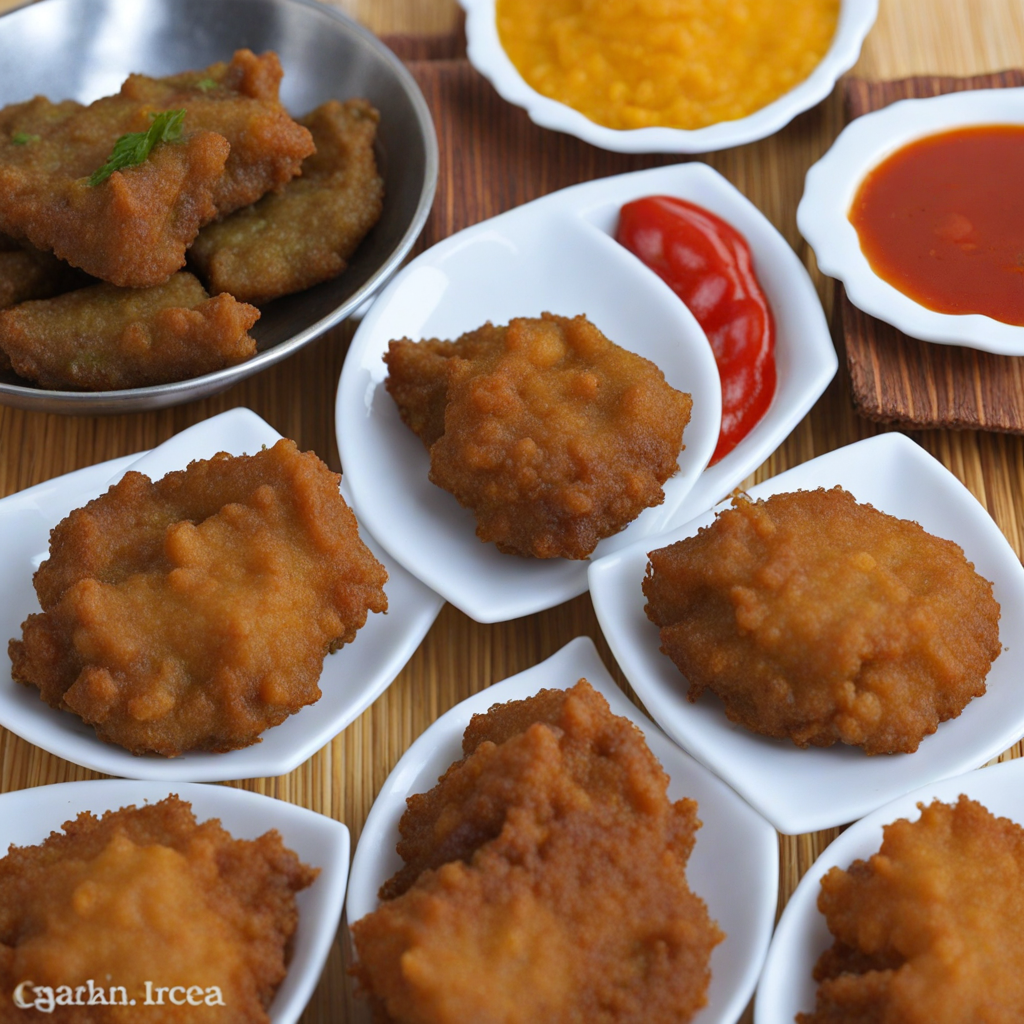Cassava Fries
Cassava fries are a delightful and crispy snack originating from Ghana, made from the starchy root vegetable known as cassava or yuca. This tuber is a staple in many West African cuisines and is celebrated for its versatility and unique flavor profile. The process of preparing cassava fries involves peeling the root, soaking it to remove excess starch, and then cutting it into thin strips before frying. The result is a golden-brown exterior that offers a satisfying crunch, while the inside remains soft and tender, creating a perfect balance of textures. What sets cassava fries apart from traditional potato fries is their slightly nutty and earthy taste, which is enhanced by the frying process. As they cook, the natural sugars in the cassava caramelize, adding a subtle sweetness that complements the savory notes. They can be seasoned with a variety of spices, such as paprika, garlic powder, or even a sprinkle of chili for those who enjoy a bit of heat. Served hot, these fries are often accompanied by dipping sauces, such as spicy pepper sauce or a tangy mayonnaise, which elevate the flavor experience even further. In Ghana, cassava fries are not just a snack; they are often enjoyed as a side dish alongside grilled meats or fish, making them a versatile addition to any meal. They embody the essence of Ghanaian street food culture, where quick, flavorful bites are a part of everyday life. Their popularity is growing beyond Ghana, and food lovers around the world are beginning to appreciate the unique taste and texture of cassava fries, making them a must-try for anyone looking to explore new culinary horizons.
How It Became This Dish
The History of Cassava Fries in Ghana #### Origins of Cassava The story of cassava, a starchy root vegetable native to South America, begins long before it found its way to the shores of Africa. Believed to have been domesticated by the indigenous peoples of Brazil and Paraguay, cassava (Manihot esculenta) was introduced to Africa in the 16th century, primarily through the transatlantic trade routes. Its adaptability to diverse climatic conditions and its ability to thrive in poor soils made cassava an attractive crop for African farmers, especially in the tropics. By the 19th century, cassava had become a staple food across the continent, particularly in West Africa, where it was embraced for its versatility and resilience. #### Cultural Significance in Ghana In Ghana, cassava holds a prominent place in the culinary landscape. It is not merely a food item but a crucial component of the cultural identity and agricultural practices of the nation. Ghanaians have developed a variety of dishes from cassava, including fufu, a traditional starchy staple served with soups and stews, and gari, a fermented and roasted form of cassava that is often used in porridge or as a side dish. The introduction of cassava fries, however, marks an evolution in how this beloved root is consumed. While cassava has been a staple for generations, the modern interpretation of cassava fries reflects a blending of traditional and contemporary culinary practices. Unlike the more common potato fries, cassava fries offer a unique taste and texture that is distinctively African, appealing to both local and international palates. #### The Emergence of Cassava Fries The transformation of cassava into fries can be attributed to a growing global interest in healthier, gluten-free alternatives to traditional fried snacks. In Ghana, as urbanization increased and the influence of Western fast food culture permeated society, cassava fries began to emerge as an appealing option. They are often seasoned with spices, fried until golden brown, and served as a snack or side dish. The preparation of cassava fries typically involves peeling and slicing the root into thin strips, soaking them to remove excess starch, and frying them until crispy. The end result is a crunchy, slightly nutty snack that can be enjoyed on its own or as an accompaniment to various dips, sauces, or main dishes. #### Health and Nutritional Value One of the remarkable aspects of cassava fries is their nutritional profile. Cassava is rich in carbohydrates, providing a significant energy source, and contains important vitamins and minerals such as vitamin C and folate. Furthermore, being gluten-free, cassava serves as a suitable option for those with gluten intolerance or celiac disease. These nutritional qualities have spurred a renewed interest in cassava as a health-conscious food choice. In recent years, there has been an increasing awareness of the need for sustainable farming practices. The cultivation of cassava has been promoted as a strategy to combat food insecurity and improve nutrition in Ghana. As a result, cassava fries are not only a tasty option but also a symbol of agricultural resilience and an embodiment of local food sovereignty. #### Cassava Fries in Modern Ghanaian Cuisine The rise of cassava fries in Ghanaian cuisine has been accompanied by a vibrant food culture that celebrates street food and casual dining. Vendors selling cassava fries can be found in bustling markets, street corners, and alongside local eateries, providing an accessible and delicious snack for people on the go. This integration into everyday life has solidified cassava fries as a beloved staple among Ghanaians of all ages. The adaptability of cassava fries extends beyond their flavor profiles. They can be seasoned with various spices, including chili powder, garlic, and traditional Ghanaian spice blends. This versatility allows for creative culinary expressions, with each vendor putting their unique twist on the classic recipe. As such, cassava fries have become a canvas for culinary experimentation, reflecting the diverse tastes and preferences of the Ghanaian populace. #### Global Recognition and Fusion Cuisine In the 21st century, as globalization continues to influence food trends, cassava fries have gained international recognition. They have made their way onto menus in restaurants beyond Ghana, appealing to health-conscious diners and food enthusiasts alike. The gluten-free trend, coupled with a growing interest in African cuisine, has catapulted cassava fries into the spotlight. Moreover, the fusion of cassava fries with other culinary traditions has opened up new avenues for innovation. For instance, they can be served alongside traditional Ghanaian dishes like kelewele (spicy fried plantains) or paired with international flavors such as garlic aioli or spicy sriracha. This blending of cultures not only showcases the versatility of cassava but also highlights the interconnectedness of global food traditions. #### Challenges and Future Prospects Despite their success, the cassava industry in Ghana faces several challenges. Issues such as climate change, pests, and diseases threaten cassava production, necessitating research and investment in sustainable agricultural practices. Additionally, as demand for cassava fries increases, ensuring a consistent supply of high-quality cassava will be essential. However, the future of cassava fries looks promising. Efforts to promote cassava cultivation and processing are gaining momentum, with initiatives aimed at enhancing value chains and improving market access for farmers. As awareness of the nutritional benefits of cassava continues to grow, cassava fries could play a crucial role in addressing food security and promoting healthier eating habits. #### Conclusion Cassava fries have evolved from a traditional staple into a contemporary culinary delight, embodying the rich agricultural heritage of Ghana while adapting to the tastes of a modern world. They serve as a testament to the resilience of Ghanaian cuisine, reflecting both the cultural significance of cassava and the innovative spirit of its people. As cassava fries continue to gain popularity both locally and globally, they stand as a delicious reminder of the enduring bond between food, culture, and community in Ghana.
You may like
Discover local flavors from Ghana







